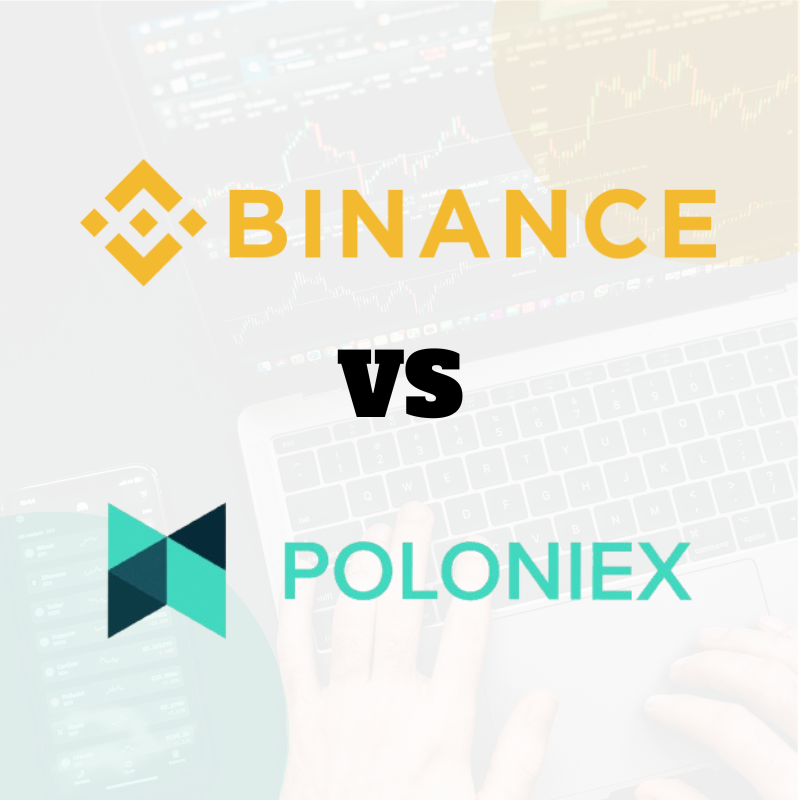Choosing between Binance vs Poloniex can be a challenge, as both platforms cater to different types of cryptocurrency traders. Binance is known for its extensive features, advanced tools, and global reach, while Poloniex offers a simpler and more focused trading experience. In this guide, we’ll dive into a detailed comparison of these two popular exchanges, covering their features, fees, security, and more to help you decide which platform best fits your trading goals.
Table of Contents
Platform Overview
Binance vs Poloniex are two of the most well-known cryptocurrency exchanges, catering to different types of traders and investors. While both platforms offer a range of features for buying, selling, and trading digital assets, they differ in terms of scale, user base, and functionality.
Binance was launched in 2017 and has grown to become one of the largest cryptocurrency exchanges in the world. It offers a wide variety of trading options, including spot trading, futures, and margin trading, along with a robust ecosystem featuring staking, lending, and a native token, BNB. Binance supports over 350 cryptocurrencies, making it a versatile platform for crypto enthusiasts.
Poloniex, founded in 2014, is an older player in the crypto space. While smaller than Binance, it is favored by some for its straightforward interface and specialized trading options. Poloniex supports fewer cryptocurrencies, but its focus on providing an accessible platform for both beginners and experienced traders has helped it maintain a dedicated user base.
Binance is better suited for those looking for advanced trading tools and a large variety of assets, while Poloniex appeals to users seeking a simpler, more streamlined experience.
User Interface and Experience
When comparing Binance vs Poloniex, the user interface and overall experience play a crucial role in determining which platform suits your needs.

Binance features a robust interface that caters to all levels of traders. It provides both a basic and advanced trading view, allowing beginners to start with simple features while experienced users can access detailed tools like advanced charts, order types, and market analysis. Binance also offers seamless integration across its web, mobile, and desktop platforms, ensuring a consistent experience regardless of the device. However, due to its extensive features, the platform may feel overwhelming to first-time users.
Poloniex, on the other hand, emphasizes simplicity and ease of use. Its clean and minimalistic interface is beginner-friendly, making it a good choice for those just starting in cryptocurrency trading. The dashboard is straightforward, with intuitive navigation and clear labeling of features. While Poloniex lacks some of the advanced tools available on Binance, it ensures a smooth experience for users who prefer a simpler trading environment.
In conclusion, Binance offers a feature-rich experience tailored to advanced users, while Poloniex provides a streamlined, user-friendly interface ideal for beginners.
Supported Cryptocurrencies
The variety of supported cryptocurrencies is a key factor when comparing Binance vs Poloniex, as it determines the trading opportunities available to users.
Binance is renowned for its extensive selection of cryptocurrencies. It supports over 350 digital assets, including popular options like Bitcoin (BTC), Ethereum (ETH), and Binance Coin (BNB), as well as many emerging altcoins. Binance regularly adds new tokens, making it an excellent choice for traders seeking access to a wide range of assets. Additionally, Binance supports various trading pairs across different fiat and cryptocurrencies, providing flexibility for diverse trading strategies.
Poloniex offers a more limited selection, with around 200 cryptocurrencies available. While this is fewer than Binance, Poloniex focuses on supporting well-established coins alongside a curated selection of lesser-known assets. This narrower range can be ideal for users who prefer a simplified portfolio or are interested in niche projects.
For traders who value access to a broader array of assets, Binance stands out. However, Poloniex’s curated approach may appeal to users who prefer a more focused selection.
Trading Features
When comparing Binance vs Poloniex, their trading features cater to different types of users. Binance focuses on a diverse and advanced trading experience, while Poloniex emphasizes simplicity and efficiency.
Binance Trading Features
- Spot Trading: Offers a wide range of trading pairs across multiple cryptocurrencies.
- Margin Trading: Allows users to trade with leverage, enhancing potential gains (or losses).
- Futures Trading: Supports high-leverage contracts for advanced traders.
- Staking and Yield Farming: Lets users earn rewards by holding specific cryptocurrencies.
- Crypto Loans: Provides borrowing and lending options for digital assets.
- Advanced Tools: Includes detailed charting, technical indicators, and order customization options.
Poloniex Trading Features
- Spot Trading: Offers simple trading for a curated list of cryptocurrencies.
- Margin Trading: Supports leveraged trading for a smaller selection of assets.
- Simplified Tools: Basic charts and analysis tools for straightforward trading.
- Automated Market Maker (AMM): A feature for users interested in providing liquidity.

Comparison
- Binance is ideal for traders seeking advanced strategies and diverse trading options.
- Poloniex appeals to users who value simplicity and efficiency without the complexity of advanced tools.
Fees and Costs
When choosing between Binance vs Poloniex, understanding their fee structures is essential for maximizing your trading profits. Both platforms use a tiered fee system, but they vary in complexity and overall costs.
Binance Fees
Binance is known for its competitive and transparent fee structure:
- Spot Trading Fees: Start at 0.10% for both makers and takers.
- Discounts: Users can lower fees by holding Binance Coin (BNB) and using it to pay trading fees, reducing costs by up to 25%.
- Futures Trading Fees: Makers pay 0.02%, and takers pay 0.04% at the base level, with reductions for higher trading volumes.
- Deposit Fees: Free for most cryptocurrencies.
- Withdrawal Fees: Vary depending on the token but are generally low.
Poloniex Fees
Poloniex offers a simpler fee structure but with slightly higher base fees:
- Spot Trading Fees: Start at 0.145% for makers and 0.155% for takers.
- Volume Discounts: Lower fees are available for traders with high 30-day trading volumes.
- Deposit Fees: Typically free, though network fees may apply for certain cryptocurrencies.
- Withdrawal Fees: Vary by asset and can be higher compared to Binance.
Security Features
When considering Binance vs Poloniex, security is a critical factor, especially given the history of cyberattacks in the cryptocurrency space. Both platforms prioritize protecting user assets and data, but their approaches differ.
Binance employs multiple layers of security to ensure user funds remain safe. It uses two-factor authentication (2FA) as a standard, requiring users to verify their login attempts through an app or SMS. Binance also supports advanced measures like address whitelisting and anti-phishing codes to safeguard accounts further. A significant highlight is its Secure Asset Fund for Users (SAFU), an emergency insurance fund to cover losses in the event of a hack. Additionally, Binance employs robust encryption and cold wallet storage for the majority of user funds.
Poloniex, while smaller, also focuses on providing a secure trading environment. It supports 2FA and email-based verification for sensitive account activities. Poloniex uses cold storage for most assets to minimize risks of hacking, with only a small portion stored in hot wallets for liquidity. Over the years, the platform has improved its security infrastructure to restore trust after earlier challenges, including a 2014 hack.
For a broader understanding of cryptocurrency security best practices, you might find this comprehensive guide byCoinGecko insightful. It covers essential strategies to protect your digital assets in the evolving crypto landscape.
While both exchanges implement strong security measures, Binance’s additional features like SAFU and more advanced user tools give it a slight edge for those seeking maximum protection.
Regulatory Compliance
Regulatory compliance is a crucial aspect when comparing Binance vs Poloniex, as it ensures user safety and platform reliability in a rapidly evolving industry.
Binance operates globally but has faced scrutiny in some regions due to varying cryptocurrency regulations. To address this, Binance has created country-specific platforms, such as Binance US, to comply with local laws. The platform has implemented Know Your Customer (KYC) protocols, requiring users to verify their identities to access full features. Binance also works to obtain licenses in regulated markets and regularly updates its policies to align with changing regulations. However, Binance’s global operations sometimes face challenges due to its expansive reach.
Poloniex, in contrast, operates on a smaller scale and has adopted a more streamlined approach to regulatory compliance. It requires KYC verification for users accessing higher trading limits or specific features. Poloniex was previously registered in the United States but moved its operations overseas to reduce regulatory pressures. This change has allowed Poloniex to continue providing its services, but it may raise concerns for users who prioritize stricter oversight.
Binance demonstrates a stronger commitment to adhering to global regulations, making it a more suitable choice for users in regions with strict compliance requirements. Poloniex, while compliant, focuses on maintaining a simplified regulatory framework.
Mobile App Performance
When comparing Binance vs Poloniex, mobile app performance is a critical consideration for users who trade on the go. Both platforms provide mobile apps, but they differ significantly in features, usability, and reliability.
Binance offers a highly advanced mobile app available for iOS and Android devices. The app is feature-rich, including access to spot trading, futures trading, staking, and even portfolio management. It is designed to cater to both beginners and advanced traders, with options to switch between “Lite” and “Pro” modes. The Lite mode simplifies the interface for casual users, while Pro mode provides advanced charts and technical tools. Binance’s app also integrates security features such as biometric login and two-factor authentication. Users generally praise the app for its smooth performance, fast order execution, and seamless navigation.

Poloniex, on the other hand, focuses on providing a straightforward mobile trading experience. Its app supports core features like spot trading, price tracking, and basic portfolio management. While the app lacks some of the advanced tools available on Binance, it is simple and user-friendly, making it ideal for beginners. However, users have occasionally reported minor issues with app stability and slower updates compared to Binance.
In summary, Binance’s mobile app excels in versatility and advanced features, while Poloniex provides a more straightforward experience for users who prioritize simplicity.
Customer Support
Customer support is a vital aspect when comparing Binance vs Poloniex, as timely and effective assistance can significantly impact the user experience.
Binance provides a comprehensive support system with multiple channels for users to resolve their issues. The platform offers a detailed help center with FAQs, guides, and troubleshooting articles. Users can also access live chat support, which is available 24/7. Additionally, Binance allows users to submit support tickets for more complex queries. While Binance’s customer service is generally responsive, some users have reported delays during peak trading periods. To complement its support system, Binance maintains an active presence on social media and a community forum where users can seek assistance and share experiences.
Poloniex also provides a help center with FAQs and basic guides, making it easy for users to find solutions to common issues. However, its customer support options are more limited compared to Binance. Poloniex primarily relies on a ticketing system for issue resolution, and while its support team responds within a reasonable time, it lacks live chat or phone support. This can be a disadvantage for users who need immediate assistance. Poloniex does have a community forum where users can discuss issues, but it is not as actively managed as Binance’s resources.
Overall, Binance offers a more robust and accessible customer support system, while Poloniex provides a simpler, ticket-based approach that may suffice for less urgent inquiries.
Educational Resources
When comparing Binance vs Poloniex, the availability of educational resources can greatly influence how easily users can learn and grow as traders.
Binance stands out with its extensive educational offerings. The platform features Binance Academy, a free resource with numerous articles and videos covering blockchain, trading strategies, and market analysis. It also includes tutorials tailored for beginners, explaining how to use the platform’s various features. For advanced users, Binance provides market insights, research reports, and webinars hosted by industry experts. Additionally, Binance’s blog and YouTube channel offer regular updates on market trends, new tokens, and platform enhancements, making it a valuable hub for ongoing education.
Poloniex, in contrast, offers more limited educational materials. The platform includes a basic help center with guides and FAQs, primarily focused on platform usage rather than broader market education. While Poloniex does have a community forum where users can share knowledge, it lacks structured content like in-depth articles, video tutorials, or webinars. This may make it less appealing for users who want to deepen their understanding of cryptocurrency trading.
For those interested in exploring other investment platforms, you might find our comparison of IBKR Lite vs Pro insightful. This article delves into the features, pricing, and tools of Interactive Brokers’ plans, aiding you in making informed decisions about your trading platform choices.
In summary, Binance is an excellent choice for users seeking comprehensive educational resources, while Poloniex provides just the essentials for getting started.
Liquidity and Market Volume
Liquidity and market volume are critical factors to consider when comparing Binance vs Poloniex, as they directly impact trading efficiency and price stability.

Binance Liquidity and Market Volume
- High Liquidity: Binance is one of the largest cryptocurrency exchanges globally, ensuring deep liquidity across most trading pairs.
- Large Market Volume: It consistently ranks among the top exchanges by daily trading volume, often exceeding billions of dollars.
- Efficient Order Execution: High liquidity minimizes slippage, allowing traders to execute large orders without significant price changes.
- Wide Range of Pairs: Binance supports hundreds of trading pairs, providing ample options for traders to diversify their portfolios.
Poloniex Liquidity and Market Volume
- Moderate Liquidity: Poloniex has decent liquidity for major cryptocurrencies but may struggle with smaller or less popular tokens.
- Lower Market Volume: As a smaller exchange, its daily trading volume is significantly lower than Binance, which can affect order execution speed.
- Focused Trading Pairs: While Poloniex offers fewer trading pairs, it maintains sufficient liquidity for its core assets.
- Niche Appeal: Poloniex is suitable for users who trade in smaller volumes or focus on specific altcoins.
Key Takeaways
- Binance is better suited for high-volume traders and those needing fast order execution with minimal slippage.
- Poloniex may appeal to users comfortable with lower volumes and simpler market activity.
Deposit and Withdrawal Options
Deposit and withdrawal options are essential considerations when comparing Binance vs Poloniex, as they determine how easily users can fund their accounts and access their funds.
Binance Deposit and Withdrawal Options
- Fiat Support: Binance allows fiat deposits via bank transfers, credit/debit cards, and third-party payment processors like PayPal in certain regions.
- Cryptocurrency Deposits: Supports a wide range of cryptocurrencies, making it easy for users to deposit almost any digital asset.
- Withdrawal Fees: Fees vary depending on the cryptocurrency, with generally competitive rates compared to other exchanges.
- Processing Time: Most withdrawals are processed quickly, though larger amounts may require manual verification.
- Multiple Fiat Currencies: Binance supports deposits and withdrawals in multiple fiat currencies, catering to a global audience.
Poloniex Deposit and Withdrawal Options
- Cryptocurrency Only: Poloniex does not currently support fiat deposits or withdrawals, making it a cryptocurrency-exclusive platform.
- Limited Deposit Methods: Users must transfer cryptocurrency from external wallets to fund their accounts.
- Withdrawal Fees: Fees are asset-specific and often slightly higher than Binance.
- Processing Speed: Most withdrawals are processed quickly, though less popular assets may take longer.
- No Fiat Gateway: Users need to rely on third-party services to convert fiat to crypto for Poloniex transactions.
Community and Reputation
The community and reputation of an exchange are important factors when comparing Binance vs Poloniex, as they reflect user trust and platform reliability.
Binance has built a strong reputation since its launch in 2017, becoming one of the most trusted names in cryptocurrency trading. It is widely regarded for its innovative features, extensive cryptocurrency support, and competitive fees. Binance has a massive and active global community, with users engaging across social media platforms, forums, and its official blog. Additionally, Binance hosts regular events like trading competitions and giveaways, fostering user participation. Despite occasional regulatory scrutiny, Binance remains a favorite among both beginner and experienced traders due to its commitment to improving the platform.
Poloniex, being an older platform established in 2014, has a smaller yet loyal community. While Poloniex faced some reputational challenges in its earlier years due to security incidents, it has since made improvements to restore user trust. The platform is praised for its simplicity and ease of use, particularly by those new to cryptocurrency trading. Poloniex has an active community forum where users can discuss issues, share insights, and connect with fellow traders. However, its reputation is less prominent compared to Binance, largely due to its smaller user base and limited global presence.
In summary, Binance enjoys a stronger global reputation and a more vibrant community, while Poloniex appeals to a niche audience with its simplicity and focused approach.
Affiliate and Referral Programs
Affiliate and referral programs are attractive features for users comparing Binance vs Poloniex, as they offer opportunities to earn rewards by inviting others to use the platform.
Binance boasts a robust affiliate and referral program designed to incentivize user growth. The Binance referral program allows users to earn up to 50% of the trading fees generated by their referrals. This percentage can vary based on the number of people referred and their trading activity. Additionally, Binance provides unique referral links and comprehensive tracking tools, making it easy for affiliates to monitor their earnings. The program is ideal for influencers, bloggers, and community leaders who can reach a large audience.
Poloniex offers a simpler referral program with straightforward rewards. Users can earn a percentage of trading fees from the individuals they refer. While Poloniex’s referral program is not as extensive as Binance’s, it provides a hassle-free way to generate passive income. However, it lacks advanced tracking tools or tiered incentives, which may limit its appeal to professional affiliates.
In summary, Binance’s affiliate and referral program is more versatile and rewarding, catering to users looking for significant earning potential. Poloniex provides a simpler alternative, suited for casual users who prefer an easy-to-manage system.
Innovation and Future Growth
Innovation and future growth are crucial factors when comparing Binance vs Poloniex, as they determine how each platform evolves to meet the needs of its users in a competitive crypto market.
Binance is widely regarded as a leader in innovation within the cryptocurrency industry. The platform consistently introduces new features and products, such as Binance Smart Chain (BSC), which supports decentralized finance (DeFi) projects and non-fungible tokens (NFTs). Binance is also expanding its ecosystem with initiatives like Binance Pay for crypto payments and Binance Earn for passive income opportunities. Additionally, the platform regularly lists new cryptocurrencies, keeping it relevant and appealing to traders seeking emerging projects. Binance’s commitment to research, development, and global expansion ensures it remains at the forefront of the crypto space.
Poloniex, while smaller in scale, has focused on steady growth and refining its user experience. The platform introduced an Automated Market Maker (AMM) feature, allowing users to participate in liquidity pools. It also aims to support niche tokens and decentralized trading. However, Poloniex’s pace of innovation is slower compared to Binance, which may limit its ability to attract new users or retain existing ones looking for advanced features.
In summary, Binance leads in innovation and long-term growth potential, constantly pushing boundaries to expand its offerings. Poloniex focuses on incremental improvements, catering to users who prefer a more stable and straightforward platform.
Conclusion
When comparing Binance vs Poloniex, it’s clear that each platform serves different types of users. Binance stands out with its extensive features, vast cryptocurrency selection, competitive fees, and industry-leading innovations, making it an excellent choice for advanced traders and those seeking a comprehensive crypto ecosystem. On the other hand, Poloniex appeals to users who prefer a simpler, more streamlined trading experience with a focus on core features and niche tokens.
Ultimately, the right platform depends on your trading needs, experience level, and priorities. Whether you value advanced tools and global scalability or a straightforward and focused approach, both Binance and Poloniex offer unique advantages. Carefully assess your goals to determine which exchange aligns best with your crypto journey.





